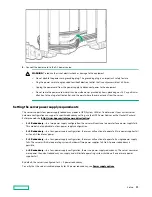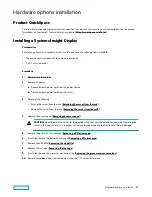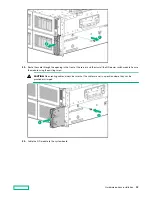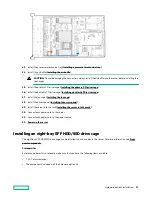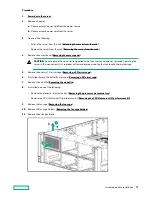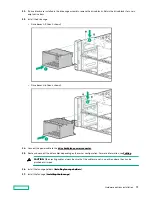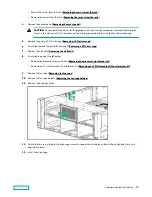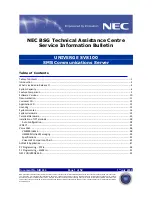
I.
From the boot screen, press
F9 to run UEFI System Utilities.
II.
Select
System Configuration > Embedded Storage: HPE Smart Storage S100i SR Gen10 > Array
Configuration > Create Array.
For more information on creating arrays using the HPE Smart Storage Administrator, see the HPE Smart
Array SR Gen10 Configuration Guide at
https://www.hpe.com/support/SSC-config.
8.
Set the server
Deploy an OS or virtualization software
9.
Do one of the following:
• To deploy an OS, run Intelligent Provisioning.
Press
F10 at the boot screen.
IMPORTANT: Smart array MR controllers are not supported by Intelligent Provisioning or Smart Storage
Administrator.
• Manually deploy an OS.
a. Insert the installation media.
For remote management, click
Virtual Drives in the iLO remote console to mount images, drivers, or files to a
virtual folder. If a storage driver is required to install the OS, use the virtual folder to store the driver.
b. To select the boot device, press F11 at the boot screen.
c. After the OS is installed, update the drivers.
10. Register the server (http://www.hpe.com/info/register).
Operational requirements
Space and airflow requirements
To allow for servicing and adequate airflow, observe the following space and airflow requirements when deciding where to
install a rack:
• Leave a minimum clearance of 63.5 cm (25 in) in front of the rack.
• Leave a minimum clearance of 76.2 cm (30 in) behind the rack.
• Leave a minimum clearance of 121.9 cm (48 in) from the back of the rack to the back of another rack or row of racks.
Hewlett Packard Enterprise servers draw in cool air through the front door and expel warm air through the rear door.
Therefore, the front and rear rack doors must be adequately ventilated to allow ambient room air to enter the cabinet, and
the rear door must be adequately ventilated to allow the warm air to escape from the cabinet.
CAUTION: To prevent improper cooling and damage to the equipment, do not block the ventilation openings.
When vertical space in the rack is not filled by a server or rack component, the gaps between the components cause
changes in airflow through the rack and across the servers. Cover all gaps with blanking panels to maintain proper airflow.
Setup
59





















